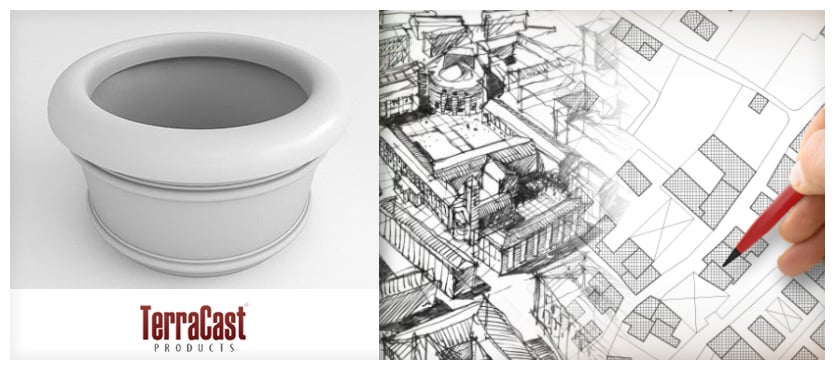When most people think of planters in the urban landscape, they picture sidewalk medians, park perimeters, or café-lined streets. But today’s architects, designers, and city planners are increasingly pushing the boundaries of traditional landscaping—bringing resin planters into unexpected and elevated environments across rooftops, building facades, parking structures, and more.
Thanks to their lightweight design, structural durability, and visual versatility, resin planters are becoming key tools in the movement to blend greenery with modern architecture. These applications not only beautify urban environments but also help address issues such as limited green space, urban heat, and pedestrian comfort. As cities continue to build upward and outward, resin planters are proving their value far beyond the sidewalk.
Why Resin Planters Are Ideal for Architectural Integration
Resin planters, especially those made with Linear Low-Density Polyethylene (LLDPE), offer several qualities that make them uniquely suited for creative applications in architecture. Compared to concrete or metal alternatives, resin planters are significantly lighter, making them ideal for installations on rooftops, balconies, and terraces where structural load matters. Yet they remain durable and impact-resistant, able to withstand harsh weather, UV exposure, and frequent use without cracking, rusting, or warping.
Resin planters are also non-porous and low-maintenance, meaning they won’t absorb water or stain, making them perfect for high-visibility and hard-to-reach areas. With a wide range of customizable colors, finishes, and sizes, architects can match resin planters to a building’s aesthetic—whether the goal is to preserve a sleek modern look or soften a space with organic textures and curves.
Rooftop Gardens and Sky Terraces
Urban rooftops are increasingly being reclaimed as communal green spaces, offering everything from outdoor dining areas to office break zones. However, rooftop applications demand materials that are both strong and lightweight, and resin planters fit the bill perfectly.
Because they can be carried and placed without heavy machinery, resin planters simplify rooftop installations. Their resistance to extreme temperature fluctuations and moisture ensures they remain reliable over time, even in open-air, sun-exposed settings. Some models can also be fitted with self-watering systems, conserving water while keeping rooftop plants healthy.
Whether arranged along the perimeter of a rooftop lounge or used to define zones within a sky terrace, resin planters provide beauty, structure, and functionality with minimal upkeep.
Parking Structures and Vertical Gardens
Concrete parking garages are often necessary but rarely beautiful. In recent years, however, designers have been transforming these utilitarian structures into green facades using vertical gardens and planter installations. Resin planters, with their flexible sizing and manageable weight, are ideal for affixing to walls, railings, and ledges.
Installed thoughtfully, resin planters can soften the look of parking garages, absorb noise, and even help lower ambient temperatures. This green transformation enhances curb appeal, improves public perception of the space, and aligns with broader sustainability goals in urban redevelopment.
Balconies and Residential Towers
In residential developments—especially high-rise towers—balconies offer a small but valuable opportunity to introduce greenery into vertical living. Traditional concrete or ceramic planters can be too heavy for balcony installations, and metal planters may corrode with time or weather exposure.
Resin planters offer a safer, long-lasting alternative. They can be anchored securely or custom-sized to fit narrow or curved balcony corners. Their resistance to rust and fading means they retain their appearance over time, even in cities with harsh winters or intense sun. In luxury towers, matching resin planter designs across all balconies can also enhance the building’s uniformity and architectural rhythm.
Urban Corridors and Skywalks
Resin planters are also being deployed in elevated pedestrian walkways and bridges, where space is limited but foot traffic is high. These areas benefit from greenery to reduce the harshness of built materials, enhance air quality, and create more inviting transitions between buildings or across thoroughfares.
Due to their durability and safety, resin planters can be used to define pedestrian lanes, introduce natural wayfinding elements, or serve as subtle security features in high-traffic zones. Their resistance to vandalism and ease of cleaning further make them a smart choice for exposed, elevated public spaces.
Interior Atriums and Lobbies
Resin planters are not just for the outdoors. In interior spaces like commercial lobbies, office atriums, and hotel lounges, large-scale planters are often used to anchor design schemes. Resin’s flexibility in shape, texture, and finish makes it ideal for matching with custom lighting, furniture, or wall treatments.
Thanks to their seamless finishes and stain-resistant surfaces, resin planters are easy to maintain in high-visibility interior spaces. They can also be equipped with built-in irrigation systems or false bottoms for easier plant care.
Expanding the Possibilities of Green Design
As cities become denser and architectural demands increase, the role of greenery is expanding—both in importance and in creativity. Resin planters offer a unique combination of form, function, and flexibility, empowering architects and designers to reimagine how and where plants can thrive in the built environment.
TerraCast® is proud to support innovative urban architecture with a wide selection of American-made, customizable resin planters designed to elevate public and private spaces alike. To explore how our lightweight and durable resin products can transform your next architectural project, contact us today.

